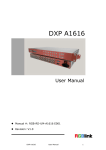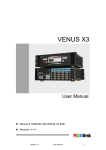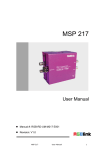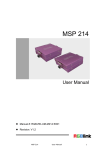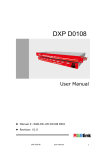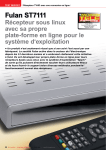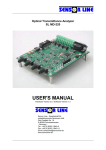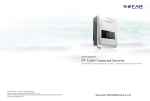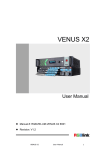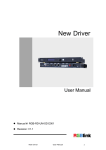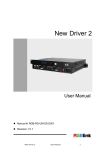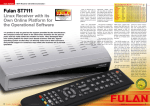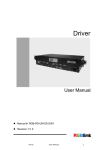Download User Manual
Transcript
DXP D1616 User Manual Manual #: RGB-RD-UM-D1616 E001 Revision: V1.1 DXP D1616 User Manual 1 DXP D1616·User Manual Thank you for choosing our products! In order to allow you to learn how to use the DVI Matrix quickly, we bring you the detailed user manual. You can read the introduction and directions before using the DVI Matrix, please read all the information we provide carefully to use our products correctly. Copyright ©2015 All rights are reserved by RGBlink. This document is done independently by Xiamen RGBlink Science & Technology Co.,LTD. No part can be copied, reproduced or translated without permission. Notice RGBlink provides this manual ―as is‖ without warranty of any kind, no matter expressed or implied, including but not limited to the implied warranties or merchantability and fitness for a particular purpose. RGBlink may make improvements or changes to the products and the programs described in this publication at any time without notice. This publication would contain technical inaccuracies or typographical errors. Changes are periodically made to the information in this publication, these changes are incorporated in new editions of this publication. Federal Communications Commission (FCC) Statement This equipment has been tested and found to comply with the limits for a class A digital device, pursuant to Part 15 of the FCC rules. These limits are designed to provide reasonable protection against harmful interference when the equipment is operated in a commercial environment. This equipment generates, uses and radiates radio frequency energy and, if not installed or used in accordance with the instruction manual, may cause harmful interference to radio communications. Operation of this equipment in a residential area may cause harmful interference, in which case the user will be responsible for DXP D1616 User Manual 2 correcting any interference. Guarantee and Compensation RGBlink provides a guarantee related to perfect manufacturing as part of the legally stipulated terms of guarantee. On receipt, the purchaser must immediately inspect all delivered goods for damage incurred during transportation, as well as for material and manufacturing faults. Please complain to RGBlink by written notice. The period of guarantee begins from the date of transfer of risks, in the case of special systems and software on the date of commissioning, at latest 30 days after the transfer of risks. In the event of justified notice of compliant, RGBlink can repair the fault or provide a replacement at its own discretion within an appropriate period. If this measure proves to be impossible or unsuccessful, the purchaser can demand a reduction in the purchase price or cancellation of the contract. All other claims, in particular those relating to compensation for direct or indirect damage, and also damage attributed to the operation of software as well as to other service provided by RGBlink, being a component of the system or independent service, will be deemed invalid provided the damage is not proven to be attributed to the absence of properties guaranteed in writing or due to the intent or gross negligence or part of RGBlink. If the purchaser or a third party carries out modifications or repairs on goods delivered by RGBlink, or if the goods are handled incorrectly, in particular if the systems are commissioned operated incorrectly or if, after the transfer of risks, the goods are subject to influences not agreed upon in the contract, all guarantee claims of the purchaser will be rendered invalid. Not included in the guarantee coverage are system failures which are attributed to programs or special electronic circuitry provided by the purchaser, e.g. interfaces. Normal wear as well as normal maintenance are not subject to the guarantee provided by RGBlink either. The environmental conditions as well as the servicing and maintenance regulations specified in this manual must be complied with the customer. Trademark Brand and product names mentioned in this manual may be trademarks, registered trademarks or copyrights of their respective holders. All brand and product names mentioned in this manual serve as comments or examples and are not to be understood as advertising for the products or their manufactures. DXP D1616 User Manual 3 Company Address Xiamen RGBlink Science & Technology Co., Ltd. Headquarter: S603~604 Weiye Building Torch Hi-Tech Industrial Development Zone Xiamen, Fujian Province, P.R.C Shenzhen office: Floor 11, A1 Building, Baiwang R&D Building, Shahe West Road, Xili Town, Nanshan District, Shezhen, Guangdong Province, P.R.C Beijing office: No. 2702, Sino-Light Building Tower B, Wang-Jing East Road, Chaoyang District, Beijing, P.R.C Shanghai office: East Building F2, No. 88 Qinjiang Road, Shanghai, P.R.C DXP D1616 Tel: +86-592-5771197 Fax: +86-592-5771202 Customer Hotline: 4008-592-315 Websites: ~ http://www.rgblink.com ~ http://www.rgblink.cn E-mail: [email protected] User Manual 4 Safe Operation Summary The general safety information in this summary is for operating personnel. Do Not Remove Covers or Panels There are no user-serviceable parts within the unit. Removal of the top panel will expose dangerous voltages. To avoid personal injury, do not remove the top panel. Do not operate the unit without the panel installed. Use the Proper Properly This product is intended to operate from a power source that will not apply more than 230 volts rms between the supply conductors or between both supply conductor and ground. A protective ground connection by way of grounding conductor in the power cord is essential for safe operation. Ground the Product Properly This product is grounded through the grounding conductor of the power cord. To avoid electrical shock, plug the power cord into a properly wired receptacle before connecting to the product input or output terminals. A protective-ground connection by way of the grounding conductor in the power cord is essential for safe operation. Use the Proper Power Cord Use only the power cord and connector specified for your product. Use only a power cord that is in good condition. Refer cord and connector changes to qualified service personnel. Use the Proper Fuse To avoid fire hazard, use only the fuse having identical type, voltage rating, and current rating characteristics. Refer fuse replacement to qualified service personnel. Do Not Operate in Explosive Dangerous Atmospheres To avoid explosion, do not operate this product in an explosive atmosphere. DXP D1616 User Manual 5 Terms and Equipment Mark in This Manual WARNING Highlight an operating procedure, practice, condition, statement, etc, which, if not strictly observed, could result in injury or death of personnel. Note Highlights an essential operating procedure, condition or statement. CAUTION The exclamation point within an equilateral triangle is intended to alert the user to the presence of important operating and maintenance (servicing) instructions in the literature accompanying the appliance. DXP D1616 User Manual 6 Amendment Record The table below lists the changes to the DVI Matrix User Manual. Format Time ECO# Description 1.0 2013-11-21 0000 Release 1.0 2015-01-20 0001 DXP D1616 1. Change the front and back panel. 2. Change the menu tree. 3. Change the windows control program. User Manual Principal Peter Vira 7 CONTENT CONTENT ............................................................................................. 8 1. Brief Introduction....................................................................... 12 Chapter Structure ............................................................................. 13 Manual Usage................................................................................... 14 Terms and Definitions ...................................................................... 15 System Overview ............................................................................. 21 Application Questions ...................................................................... 22 2. Hardware Orientation ................................................................ 23 In This Chapter ................................................................................. 23 DXP D1616 Front Panel .................................................................. 24 LCD Panel ................................................................................................. 24 Indicator ..................................................................................................... 24 IR Receiver ............................................................................................... 25 Function Button ........................................................................................ 25 DXP D1616 Back Panel .................................................................. 27 3. Hardware Installation ................................................................ 28 In This Chapter ................................................................................. 28 Safety Precautions ........................................................................... 29 Unpacking and Inspection ............................................................... 29 DXP D1616 User Manual 8 Site Preparation ................................................................................ 29 4. Menu Orientation ....................................................................... 30 In This Chapter ................................................................................. 30 MENU ................................................................................................ 31 Status ......................................................................................................... 31 Reset .......................................................................................................... 31 LOGO ......................................................................................................... 31 EDID ........................................................................................................... 32 Language .................................................................................................. 32 Cascade .................................................................................................... 32 Mac Addr ................................................................................................... 32 Lock ............................................................................................................ 32 Hot Backup................................................................................................ 32 Auto Take................................................................................................... 33 Work Time ................................................................................................. 33 Mute ........................................................................................................... 33 5. Communication Software Guideline ....................................... 34 In This Chapter ................................................................................. 34 Software Installation......................................................................... 35 Software Operation .......................................................................... 39 File Toolbar ................................................................................................ 39 DXP D1616 User Manual 9 Communication Toolbar .......................................................................... 44 Input and Output Signal .......................................................................... 46 Save/Load User Mode ............................................................................ 47 Information Toolbar .................................................................................. 47 How to Connect Windows Control Program by RS232 Interface48 6. System Setup and Operations................................................. 50 In This Chapter ................................................................................. 50 How to Switch between Input and Output Channel...................... 51 How to Switch One Input to all Outputs ......................................... 53 How to Read Device Status ............................................................ 54 How to Set LOGO Display when Power on................................... 55 How to Set the EDID ........................................................................ 56 How to Set the Language ................................................................ 57 How to Realize Cascade Setting .................................................... 58 How to Set the Machine Address ................................................... 59 How to Realize Signal Auto Take ................................................... 60 How to Lock the Front Panel........................................................... 61 How to Realize Hot Backup ............................................................ 62 How to Save the Preset Input and Output Channel ..................... 63 How to Load the Saved Input and Output Channel...................... 64 How to Reset the Factory Settings................................................. 65 7. Common Questions and Solutions ........................................ 66 DXP D1616 User Manual 10 In this chapter ................................................................................... 66 A. Specification .............................................................................. 68 B. Contact Information .................................................................. 69 C. Software Upgrade ..................................................................... 70 MCU Program Upgrade ................................................................... 70 D. Serial Communication Protocol ............................................. 72 DXP D1616 User Manual 11 1. Brief Introduction This chapter is designed to introduce you to the DXP D1616 User Manual. It covers: Chapter Structure Manual Usage Terms and Definitions System Overview Application Questions DXP D1616 User Manual 12 1. Brief Introduction Chapter Structure Chapter Structure The following chapters provide instructions for all aspects of DXP D1616 operations: Chapter 1 Brief Introduction Chapter 2 Hardware Orientation Chapter 3 Hardware Installation Chapter 4 Menu Orientation Chapter 5 Communication Software Guideline Chapter 6 System Setup and Operations Chapter 7 Common Questions and Solution Appendix A Specification Appendix B Contact Information Appendix C Software Upgrade Appendix D Serial Communication Protocol DXP D1616 User Manual 13 1. Brief Introduction Manual Usage Manual Usage Following are important tips for streamlining your use of this User Manual in its electronic ―PDF‖ form. Navigation Use Acrobat Reader’s ―bookmarks‖ to navigate to the desired location. All chapter files have the same bookmark structure for instant navigation to any section. Please note: Extensive hyperlinks are provided within the chapters. Use Acrobat’s ―Go to Previous View‖ and ―Return to next View‖ buttons to trace your complete navigational path. Use the ―Previous Page‖ and ―Next Page‖ buttons to go to the previous or next page within a file. Use Acrobat’s extensive search capabilities, such as the ―Find‖ tool and ―Search Index‖ tool to perform comprehensive searches as required. Catalogue and Index Use the Table of Contents bookmarks to navigate a desired topic. Click any item to instantly jump to that section of the guide. You can also use the Index to jump to specific topics within a chapter. Each page number in the Index is a hyperlink. DXP D1616 User Manual 14 1. Brief Introduction Terms and Definitions Terms and Definitions The following terms and definitions are used throughout this Manual; “ASCII”: American Standard for Information Interchange. The standard code consisting of 7-bit coded characters (8 bits including parity check) used to exchange information between data processing systems, data communication systems, and associated equipment. The ASCII set contains control characters and graphic characters. “Aspect ratio”: The relationship of the horizontal dimension to the vertical dimension of an image. In viewing screens, standard TV is 4:3, or 1.33:1; HDTV is 16:9, or 1.78:1. Sometimes the ―:1‖ is implicit, making TV = 1.33 and HDTV = 1.78. “AV”: Audio visual or audio video. A “Background” is an unscaled source, typically originating from a computer. A background source appears at the system’s lowest priority — visually in back of all other sources. “Baudrate”: Named of J.M.E. Baudot, the inventor of the Baudot telegraph code. The number of the electrical oscillations per second, called baud rate. Related to, but not the same as, transfer rate in bits per second (bps). “Blackburst”: The video waveform without the video elements. It includes the vertical sync, horizontal sync, and the chroma burst information. Blackburst is used to synchronize video equipment to align the video output. One signal is normally used to set up an entire video system or facility. Sometimes it is called House sync. “BNC”: Bayonet Neill-Concel man. A cable connector used extensively in television and named for its inventors. A cylindrical bayonet connector that operates with a twist-locking motion. To make the connection, align the two curved grooves in the collar of the male connector with the two projections on the outside of the female collar, push, and twist. This allows the connector to lock into place without tools. “Brightness”: Usually refers to the amount or intensity of video light produced on a screen without regard to color. Sometimes called ―black level. ―CAT 5‖: Category 5. Describes the network cabling standard that consists of four unshielded twisted pairs of copper wire terminated by RJ-45 connectors. CAT 5 cabling supports data rates up to 100 Mbps. CAT 5 is based on the EIA/TIA 568 Commercial Building Telecommunications Wiring Standard. “Color bars”: A standard test pattern of several basic colors (white, yellow, cyan, green, magenta, red, blue, and black) as a reference for system alignment and testing. In NTSC video, the most commonly used color bars are the SMPTE standard color bars. In PAL video, the most commonly used color bars are eight full field bars. In the DXP D1616 User Manual 15 1. Brief Introduction Terms and Definitions computer, the most commonly used color bars are two rows of reversed color bars. “Color burst”: In color TV systems, a burst of sub-carrier frequency located on the back porch of the composite video signal. This serves as a color synchronizing signal to establish a frequency and phase reference for the chrome signal. Color burst is 3.58 MHz for NTSC and 4.43 MHz for PAL. “Color temperature”: The color quality, expressed in degrees Kelvin (K), of a light source. The higher the color temperature, the bluer the light. The lower the temperature, the redder the light. Benchmark color temperature for the A/V industry includes 5000°K, 6500°K, and 9000°K. “Contrast ratio”: The radio of the high light output level divided by the low light output level. In theory, the contrast radio of the television system should be at least 100:1, if not 300:1. In reality, there are several limitations. In the CRT, light from adjacent elements contaminate the area of each element. Room ambient light will contaminate the light emitted from the CRT. Well-controlled viewing conditions should yield a practical contrast ratio of 30:1 to 50:1. “DVI”: Digital Visual Interface. The digital video connectivity standard that was developed by DDWG (Digital Display Work Group). This connection standard offers two different connectors: one with 24 pins that handles digital video signals only, and one with 29 pins that handles both digital and analog video. “EDID”: Extended Display Identification Data – EDID is a data structure used to communicate video display information, including native resolution and vertical interval refresh rate requirements, to a source device. The source device will then output the optimal video format for the display based on the provided EDID data, ensuring proper video image quality. This communication takes place over the DDC – Display Data Channel. “Ethernet”: A Local Area Network (LAN) standard officially known as IEEE 802.3. Ethernet and other LAN technologies are used for interconnecting computers, printers, workstations, terminals, servers, etc. within the same building or campus. Ethernet operates over twisted pair and over coaxial cable at speeds starting at 10Mbps. For LAN interconnectivity, Ethernet is physical link and data link protocol reflecting the two lowest layers of the OSI Reference Model. “Frame”: In interlaced video, a frame is one complete picture. A video frame is made up of two fields, or two sets of interlaced lines. In a film, a frame is one still picture of a series that makes up a motion picture. “Gamma”: The light output of a CRT is not linear with respect to the voltage input. The difference between what you should have and what is actually output is known as gamma. “HDMI” - High – Definition Multimedia Interface: An interface used primarily in consumer electronics for the transmission of DXP D1616 User Manual 16 1. Brief Introduction Terms and Definitions uncompressed high definition video, up to 8 channels of audio, and control signals, over a single cable. HDMI is the de facto standard for HDTV displays, Blu-ray Disc players, and other HDTV electronics. Introduced in 2003, the HDMI specification has gone through several revisions. “HDSDI”: The high-definition version of SDI specified in SMPTE-292M. This signal standard transmits audio and video with 10 bit depth and 4:2:2 color quantization over a single coaxial cable with a data rate of 1.485 Gbit/second. Multiple video resolutions exist including progressive 1280x720 and interlaced 1920x1080 resolutions. Up to 32 audio signals are carried in the ancillary data. “JPEG” (Joint photographic Expects Group): Commonly used method of lost compression for photographic images using a discreet cosine transfer function. The degree of compression can be adjusted, allowing a selectable tradeoff between storage size and image quality. JPEG typically achieves 10:1 compression with little perceptible loss in image quality. Produces blocking artifacts. “MPEG”: Motion Picture Expect Group. A standard committee under the auspices of the International Standards Organization working on algorithm standards that allow digital compression, storage and transmission of moving image information such as motion video, CD-quality audio, and control data at CD-ROM bandwidth. The MPEG algorithm provides inter-frame compression of video images and can have an effective compression rate of 100:1 to 200:1. “NTSC”: The color video standard used in North America and some other parts of the world created by the National Television Standards Committee in the 1950s. A color signal must be compatible with black-and-white TV sets. NTSC utilizes an interlaced video signals, 525 lines of resolution with a refresh rate of 60 fields per second (60 Hz). Each frame is comprised of two fields of 262.5 lines each, running at an effective rate of 30 frames per second. “Operator”: Refers to the person who uses the system. “PAL”: Phase Alternate Line. A television standard in which the phase of the color carrier is alternated from line to line. It takes four full pictures (8 fields) for the color-to-horizontal phase relationship to return to the reference point. This alternation helps cancel out phase errors. For this reason, the hue control is not needed on a PAL TV set. PAL, in many transmission forms, is widely used in Western Europe, Australia, Africa, the Middle East, and Micronesia. PAL uses 625-line, 50-filed (25 fps) composite color transmission system. “PIP”: Picture-in-Picture. A small picture within a larger picture created by scaling down one of the images to make it smaller. Each picture requires a separate video source such as a camera, VCR, or computer. Other forms of PIP displays include Picture-by-Picture (PBP) and Picture-with-Picture (PWP), which are commonly used with 16:9 aspect display devices. PBP and PWP image formats require a DXP D1616 User Manual 17 1. Brief Introduction Terms and Definitions separate scaler for each video window. “Polarity”: The positive and negative orientation of a signal. Polarity usually refers to the direction or a level with respect to a reference (e.g. positive sync polarity means that sync occurs when the signal is going in the positive direction). “RJ-45”: Registered Jack-45. A connector similar to a telephone connector that holds up to eight wires used for connecting Ethernet devices. ―RS-232”: An Electronic Industries Association (EIA) serial digital interface standard specifying the characteristics of the communication path between two devices using either DB-9 or DB-25 connectors. This standard is used for relatively short-range communication and does not specify balanced control lines. RS-232 is a serial control standard with a set number of conductors, data rate, word length, and type of connector to be used. The standard specifies component connection standards with regard to the computer interface. It is also called RS-232-C, which is the third version of the RS-232 standard, and is functionally identical to the CCITT V.24 standard. “Saturation”: Chroma, chroma gain. The intensity of the color, or the extent to which a given color in any image is free from white. The less white in a color, the truer the color or the greater its saturation. On a display device, the color control adjusts the saturation. Not to be confused with the brightness, saturation is the amount of pigment in a color, and not the intensity. Low saturation is like adding white to the color. For example, a low-saturated red looks pink. “Scaling”: A conversion of a video or computer graphic signal from a starting resolution to a new resolution. Scaling from one resolution to another is typically done to optimize the signal for input to an image processor, transmission path or to improve its quality when presented on a particular display. “SDI”: Serial Digital Interface. The standard based on a 270 Mbps transfer rate. This is a 10-bit, scrambled, polarity independent interface with common scrambling for both component ITU-R 601 and composite digital video and four channels of (embedded) digital audio. “Seamless Switching”: A feature found on many video switchers. This feature causes the switcher to wait until the vertical interval to switch. This avoids a glitch (temporary scrambling) which normally is seen DXP D1616 User Manual 18 1. Brief Introduction Terms and Definitions when switching between sources. “SMPTE”: Society of Motion Picture and Television Engineers. A global organization, based in the United States that sets standards for base band visual communications. This includes film as well as video and television standards. “S-video”: A composite video signal separated into the luma (―Y‖ is for luma, or black and white information; brightness) and the chroma (―C‖ is an abbreviation for chroma, or color information). “Sync”: Synchronization. In video, sync is a means of controlling the timing of an event with respect to other events. This is accomplished with timing pulses to insure that each step in a process occurs at the correct time. For example, horizontal sync determines exactly when to begin each horizontal scan line. Vertical sync determines when the image is to be refreshed to start a new field or frame. There are many other types of sync in video system.(Also known as ―sync signal‖ or ―sync pulse.‖) “TCP/IP”: Transmission Control Protocol/Internet Protocol. The communication protocol of the Internet. Computers and devices with direct access to the Internet are provided with a copy of the TCP/IP program to allow them to send and receive information in an understandable form. “USB”: Universal Serial Bus. USB was developed by seven PC and telecom industry leaders (Compaq, DEC, IBM, Intel, Microsoft, NEC, and Northern Telecom). The goal was easy plug-and-play expansion outside the box, requiring no additional circuit cards. Up to 127 external computer devices may be added through a USB hub, which may be conveniently located in a keyboard or monitor. USB devices can be attached or detached without removing computer power. The number of devices being designed for USB continues to grow, from keyboards, mice, and printers to scanners, digital cameras, and ZIP drives. “VESA”: Video Electronics Standards Association. A nonprofit number organization dedicated to facilitating and promoting personal computer graphics through improved standards for the benefit of the end-user. www.vesa.org. “VGA”: Video Graphics Array. Introduced by IBM in 1987, VGA is an DXP D1616 User Manual 19 1. Brief Introduction Terms and Definitions analog signal with TTL level separate horizontal and vertical sync. The video outputs to a 15-pin HD connector and has a horizontal scan frequency of 31.5 kHz and vertical frequency of 70 Hz (Mode 1, 2) and 60 Hz (Mode 3). The signal is non-interlaced in modes 1, 2, and 3 and interlaced when using the 8514/A card (35.5 kHz, 86 Hz) in mode 4. It has a pixel by line resolution of 640×480 with a color palette of 16 bits and 256,000 colors. “YCrCb”: Used to describe the color space for interlaced component video. “YPbPr”: Used to describe the color space for progressive-scan (non-interlaced) component video. DXP D1616 User Manual 20 1. Brief Introduction System Overview System Overview RGBlink strong technical strength determines the high quality of AVDXP series matrix switchers. We choose the chips with best performance, elaborate design for every way of switchers, to ensure the high quality of switchers. After rigorous testing, 3G/HD/SD-SDI video signal, optical signal transmission rate are 2.97Gbps, DVI switchers signal bandwidth is 2.5 GHz, support HD digital signal input. VGA switching signal bandwidth is 450 MHz (-3 db), support resolution of 2048×1536 60hz and 1024×768 120hz, composite video bandwidth for 100 M (-3 db), fully meet various strict requirements and high quality occasions. Products in this series are widely used in large screen projection display engineering, electronic teaching, command and control center, multimedia meetings room, etc. Switches in this series are equipped with monochromatic LCD, RS-232 communication interface, RS422 communication interface (optional), with outage protect function, can read and store up to 100 user scenarios, and special matching control software, can in conjunction with computer, remote control system or all kinds of distal control equipment (such as center console system). The system is equipped with multiple sets of serial instructions, compatible with mainstream matrix of serial instruction set. DXP D1616 User Manual 21 1. Brief Introduction Application Questions Application Questions RGBlink offers solutions to demand technical problems. Any application questions, or required further information, please contact with our Customer Support Engineers. Refer to Appendix B for contact details. DXP D1616 User Manual 22 2. Hardware Orientation In This Chapter This chapter provides detailed information about the DXP D1616 panel. The following topics are discussed: DXP D1616 Front Panel DXP D1616 Back Panel DXP D1616 User Manual 23 2. Hardware Orientation DXP D1616 Front Panel DXP D1616 Front Panel Brief introduction of DXP D1616 front panel as the following picture: The front panel consist of LED screen, indicator, IR receiver and buttons, the button is for control command inputting, the LED screen is composed of 128*16 points, and used to display the operation and running state, the indicator shows the operating status. LCD Panel Used to display the current status and prompting message. Plug into the power cord and push the power button to ―ON‖, the LCD module on the front panel will show RGBLINK and go into self verification. For the first setup, it is default for factory setting. With front panel keyboard, user can operate DXP D1616 through the menus on LCD panel. DXP D1616 front panel as shown in figure: RGBLINK DXP D1616 123456789ABCDEFG 123456789ABCDEFG Indicator Power: The red power indicator is on when there is power supply. Mode: When switch audio and image at the same time, the yellow mode DXP D1616 User Manual 24 2. Hardware Orientation DXP D1616 Front Panel indicator is on. (DXP D1616 V1.1 can not support this function) Com: When connect device for cascade, the green Com indicator is on. IR Receiver Can receive the infrared signal. Function Button [1] ~ [16] Digital button: Selection button for input and output channel, used to set video signal input and output channel, also, can be used to number choice of save or call saving modes. [MENU]: Menu and up arrow button. Push the button to enter into the menu items. In menu state, push the menu to exit the current state to the previous state. [NEXT]: Down arrow button. [TAKE]: Confirm button. [ALL]: Distributor selection button, it will output one input to all outputs. For example: When switch off the ―AUTO TAKE‖ function, push the [ALL] → [5] → [Enter] button, it will distribute the input of channel 5 to all outputs. [SAVE]: Save button, save all current switching channels and current states, the buttons [1]~[16] in output channel correspond to save 1~16, and the buttons [1]~[16] in input channel correspond to save 17~32, a total of 32 kinds of saving modes. For example: Push the [SAVE] button, then push the [6] button in output channel, the current state will be saved to SAVE 6. Note If power fails suddenly, the device will automatically save to the current using mode, and do not need reset when power on. [LOAD]: Load button, load all the saved modes, the buttons [1]~[16] in DXP D1616 User Manual 25 2. Hardware Orientation DXP D1616 Front Panel output channel correspond to save 1~16, and the buttons [1]~[16] in input channel correspond to save 17~32, a total of 32 kinds of saving modes. For example: Push the [LOAD] button, then push the [3] button in output channel, user can load SAVE 3. DXP D1616 User Manual 26 2. Hardware Orientation DXP D1616 Back Panel DXP D1616 Back Panel Brief introduction of DXP D1616 back panel as the following picture: The port marked with "DVI-D INPUTS" is input ports, connecting the signal source, and video signal from laptop. The port marked with "DVI-D OUTPUTS" is output ports, connecting monitor, projectors and other display device. RS 232 IN is the interface connecting serial communication interface of RS-232 control protocol, can connect central control device, such as CP 2048. RS 232 OUT is the serial communication interface of multiple devices cascading control, can connect many sets of DXP devices. Power and switch: AC 85-264V 3.8A 50/60Hz IEC-3. DXP D1616 User Manual 27 3. Hardware Installation In This Chapter This chapter provides comprehensive installation instruction for DXP D1616 hardware: Following is the size of DXP D1616 for your reference. DXP D1616 User Manual 28 Safety Precautions For all DXP D1616 DVI Matrix installation procedures, please observe the following important safety and handling rules to avoid damage to yourself and the equipment. To protect users from electric shock, ensure that the chassis connects to earth via the ground wire provided in the AC power Cord. The AC Socket-outlet should be installed near the equipment and be easily accessible. Unpacking and Inspection Before opening DXP D1616 DVI Matrix shipping box, inspect it for damage. If you find any damage, notify the shipping carrier immediately for all claims adjustments. As you open the box, compare its contents against the packing slip. If you find any shortages, contact your sales representative. Once you have removed all the components from their packaging and checked that all the listed components are present, visually inspect the system to ensure there was no damage during shipping. If there is damage, notify the shipping carrier immediately for all claims adjustments. Site Preparation The environment in which you install your DXP D1616 should be clean, properly lit, free from static, and have adequate power, ventilation, and space for all components. DXP D1616 User Manual 29 4. Menu Orientation In This Chapter This chapter describes all DXP D1616 processor menus, including how they are accessed, the functions that are available, and descriptions of each menu tree (in block diagram format). The following topics are discussed: • MENU Status Reset LOGO EDID Language Cascade Mac Addr Lock Hot Backup Auto Take Work Time Mute DXP D1616 User Manual 30 4. Menu Orientation Menu MENU Push the [MENU] button to enter the menu items, shown as below. Push the [MENU] up arrow reuse button and [NEXT] down arrow button to select menu items. Push the [TAKE] button to enter corresponding setting or view the menu. Status User can view the current device status. The first four screen show each output to the corresponding input channel. The fifth screen shows the software version, the sixth screen shows the serial number and the seventh screen shows the machine address. Reset Enter to reset menus, push any button to reset to its factory settings, push the [MENU] button to exit. LOGO Push the [MENU] button to enter to the menu items. Push the [MENU] or [NEXT] button, and choose <LOGO>, push the [NEXT] button, choose <ON>, the device will show the LOGO. Push the [TAKE] button to confirm. DXP D1616 User Manual 31 4. Menu Orientation Menu EDID EDID is extended display identification data, used to identify the input video display information. When DXP D1616 is unable to detect the input signal, but the input signal can be normal in the display, enable the EDID function, it will copy the EDID of output port to one or all input ports of the monitor. Language User can choose Chinese or English according to their needs to operate the interface more quickly. Cascade Push the [MENU] button to enter to the menu items. Push the [MENU] or [NEXT] button, and choose <CASCADE>, user can check and set cascade. Then push the [TAKE] button to confirm. Mac Addr The machine address need to modify when use one windows control program, and when use more windows control program, user need to set up different machine address. This function is cascade multiple machines of different address, and controlled by windows control program. Lock In order to avoid the wrong operations, user can lock front panel. Push MENU key for 3 seconds to unlock panel. Hot Backup User can turn on or off the hot backup function, push the [TAKE] button to DXP D1616 User Manual 32 4. Menu Orientation Menu confirm after set. Inputs 1 ~ 8 are any combination of backup, it will recall another backup if one signal has problem. The detailed parameters can be set on windows control program, and invalid for button operation. Auto Take Push the [MENU] button to enter to the menu items. Push the [MENU] or [NEXT] button, and choose <AUTO TAKE>, push the [NEXT] button to turn on or off the auto take function, push the [TAKE] button to confirm. System default turn on this function, and user need not to push the [TAKE] button to confirm when switch the signal. Work Time Push the [MENU] button to enter to the menu items. Push the [MENU] or [NEXT] button, and choose <WORK TIME>, user can view the boot times and total time. Mute Push the [MENU] button to enter to the menu items. Push the [MENU] or [NEXT] button, and choose <MUTE>, user can turn on or off the mute function. After setting, push the [TAKE] button to confirm. DXP D1616 User Manual 33 5. Communication Software Guideline In This Chapter This chapter provides detailed information about the control communication software. The following topics are discussed: Software Installation Software Operation How to Connect Windows Control Program by RS232 Interface DXP D1616 User Manual 34 5. Communication Software Guideline Software Installation Software Installation DXP D1616 video processor is very easy to be configured with user friendly communication software for edit and display. Double click to install, English version default for use, click ―Next‖ to next dialog: And in next dialog is the user agreement of the software, click Agree to go on: DXP D1616 User Manual 35 5. Communication Software Guideline Software Installation User can select ―Change‖ to choose the DXP D1616 install software: DXP D1616 User Manual 36 5. Communication Software Guideline Software Installation Click ―Next‖ to go on: Click ―Next‖ to go on: DXP D1616 User Manual 37 5. Communication Software Guideline Software Installation Click ―Next‖ to go on: Click ―Finish‖ and ready to run DXP D1616 console: DXP D1616 User Manual 38 5. Communication Software Guideline Software Operation Software Operation Install communication which comes with the package of DXP D1616 device. Double click icon from home screen, and double click to run the software. DXP D1616 communication software interface as shown: File Toolbar File Toolbar includes four options, Control, Language, Admin and Help. Control Control includes nine options: In Port EQ, Out Port Driver, EDID Study, Com Setup, Machine Addr, Hot Backup, Device Update, Logo Info and Factory Setup, interface as shown: DXP D1616 User Manual 39 5. Communication Software Guideline Software Operation In port EQ: If extend the DVI input cable, user need to adjust the EQ value of compensation to ensure signal receiving. Select ―All‖, all the inputs will be set to the same value. User can read the EQ after write it. Select ―Write‖ to write the EQ, and select ―Read‖ to read it. Out port Driver: If extend the DVI input cable, user need to adjust the out port driver value of compensation to ensure signal transmission. Select ―All‖, all the inputs will be set to the same value. Select ―Write‖ to write the EQ, and select ―Read‖ to read it. EQ and Out Driver values table: DXP D1616 User Manual 40 5. Communication Software Guideline Software Operation Cable length(m) EQ Values DRIVE Values 1.5 0-5 0-3 1.5 3 0-5 0-3 1.5 16.5 0-4 1-3 1.5 30 0-5 1-3 3 1.5 0-1 0-3 3 3 0-4 0-3 3 16.5 0-1 1-3 3 30 0-4 1-3 Input cable Out cable 1.5 EDID study: EDID is extended display identification data, used to identify the input video display information. When DXP D1616 is unable to detect the input signal, but the input signal can be normal in the display, the use of EDID Study function will copy the output port is connected to the input port of the monitor of the EDID, the device can identify the input signal. Interface as shown: Comm Setup: When control DXP D1616 via windows control program, set the COM first. For example, set CommPort as COM1 which is checked from device manager, set BoudRate to as 9600, Click [OK] after setting. DXP D1616 User Manual 41 5. Communication Software Guideline Software Operation Machine Addr: The machine address need to modify when use one windows control program, and when use more windows control program, user need to set up different machine address. Set from 1, click the up/down arrow to select the machine address, for example, select 2, click ―Set‖ to confirm. Hot Backup: Choose Hot Backup ON before set hot backup. Inputs 1~8 are any combination of backup, it will recall another backup if one signal has problem. Device Update: Click to choose the file path, then click ―Start‖ to update the device. DXP D1616 User Manual 42 5. Communication Software Guideline Software Operation Logo Info: Click the □ beside ―Logo ON/OFF‖ if need to set Logo Info. Click the □ beside ―Custom Logo ON/OFF‖ to turn on the custom logo function. Move the position by or click ―Default‖ to adjust the display time. Adjust up/down arrow and input the information. Click ―Set‖ after setting. Factory Setup: Click ―Factory Setup‖ to reset to its factory settings. Language Click the ―Language‖ option and choose language version, for example, choose ―English‖, click ―English‖, the interface will be switched to English. Admin Advance debug is only done by engineer. Please connect us for password. DXP D1616 User Manual 43 5. Communication Software Guideline Software Operation Help Version explain: Software version history About: Display information of software. Communication Toolbar Communication Toolbar includes three options as follows: : Open comm. : Synchronization. : Cascade. Open Comm After set the serial, click icon to open the comm, when open comm, the will turn to green icon DXP D1616 , and the red icon will turn to . User Manual 44 5. Communication Software Guideline Software Operation Click the icon to close comm, then the green icon will return to the red icon . Synchronization When two devices work synchronously, and user need to get the same operation both for DXP D1616 and windows control program, click the synchronization icon . For example, select input 2, output 3 in the front panel of DXP D1616, then click the synchronization icon , the windows control program will synchronization to the current state. Cascade When connect the second device with serial cable, click the cascade icon DXP D1616 User Manual 45 5. Communication Software Guideline Software Operation , then it will search the cascade device, and will display the machine address of one device on the page. Left click ―4‖ and enter to the widows control program page, user can operate on this page. Input and Output Signal Support 16 kinds of input signals, and each input corresponding to different colors. Click input channel 1 in Input area, and click output channel 1 on Output area, then the color of output channel 1 will corresponding to the color of input channel 1. User can also set one input to more outputs. Click input channel 1 in Input area, and click output channel 1, 2, 3 in Output area, output 1, 2 3 will output signal 1, and the color of output channel 1, 2, 3 will corresponding to the color of input channel 1. If need to close one output signal, for example, close output 3, click ―0‖ in Input area, then click ―3‖ in Output area, output 3 is closed, and turn to original gray. DXP D1616 User Manual 46 5. Communication Software Guideline Software Operation If need to set one input to all outputs, for example, set input 1 to 16 outputs, click input channel 1 in Input area, then click ―All‖ in Output area, all outputs will switch to input 1. Save/Load User Mode DXP D1616 provides 24 kinds of save modes. User can save the parameters in Save User Mode area, and load the saved parameters in Load User Mode area. Information Toolbar It shows the connect status, software version, and so on. DXP D1616 User Manual 47 5. Communication Software Guideline How to Connect Windows Control Program by RS232 Interface How to Connect Windows Program by RS232 Interface Control Firstly, install the control software in your PC. Connect one end of RS232 cable to the DXP D1616, and the other end to the serial port on the PC. If there is no serial port in the PC, it needs the Serial to USB adapter. Right click [My Computer] on the home screen of control PC. Enter to [Attribute], Find [Hardware] option, as following. Click [Device Manager] ―+‖ on the left, check the COM number, as following, COM1 is offered. DXP D1616 User Manual 48 5. Communication Software Guideline How to Connect Windows Control Program by RS232 Interface Remember the COM you are using and then run the control software, find [Communication] option. System default for the first time, user have to click button, as following: Check and tap [Serial], Serial Port , for example, is COM1 which is checked from device manager. Set DXP D1616 Boud Rate to be: 9600, Click [Confirm] after setting. Click [open serial], check if [COM] icon is on the bottom right corner, when there is the prompt green showing on the software, it means the communication is ok , and you can use the software to control the device now. DXP D1616 User Manual 49 6. System Setup and Operations In This Chapter This chapter focuses on system setup and operation, mainly including the following contents: How to Switch between Input and Output Channel How to Switch One input to all Outputs How to Read Device Status How to Set LOGO Display when Power on How to Set the EDID How to Set the Language How to Realize Cascade Setting How to Set the Machine Address How to Realize Signal Auto Take How to Lock the Front Panel How to Realize Hot Backup How to Save the Preset Input and Output Channel How to Load the Saved Input and Output Channel How to Reset the Factory Settings DXP D1616 User Manual 50 6. System Setup and Operations How to Switch between Input and Output Channel How to Switch between Input and Output Channel User can switch the signals between input and output channel by front panel buttons of DXP D1616, specific operations are as follows: 1. If choose ―AUTO TAKE ON‖, push any button on output area in the front panel, for example, choose [5] as the output channel. O:123456789ABCDEFG I :123456789ABCDEFG Then push any button on Input area in the front panel, for example, choose [3] as the input channel, the signal of output channel 5 will be switched to the signal of input 3. O:123456789ABCDEFG I :123436789ABCDEFG 2. If choose ―AUTO TAKE OFF‖, push any button on output area on the front panel, for example, choose [5] as the output channel. O:123456789ABCDEFG I :123456789ABCDEFG Then push any button on input area on the front panel, for example, choose [3] as the input channel. O:123456789ABCDEFG I :123436789ABCDEFG After setting, push the [TAKE] button to confirm. O:123456789ABCDEFG I :123436789ABCDEFG DXP D1616 User Manual 51 6. System Setup and Operations How to Switch between Input and Output Channel Note Input channel: The signal that will be switched to output channel. Output channel: The signal that connected to display device. The number [1]~[16] means channel 1~16. DXP D1616 User Manual 52 6. System Setup and Operations How to Switch One Input to all Outputs How to Switch One Input to all Outputs 1. If choose ―AUTO TAKE ON‖, push the [ALL] button on the front panel. O:123456789ABCDEFG I :123456789ABCDEFG Then push any button on input area on the front panel, for example, choose [3] as the input channel, all the signal of output channel will be switched to the signal of input 3. O:123456789ABCDEFG I :3333333333333333 2. If choose ―AUTO TAKE OFF‖, push the [ALL] button on the front panel. O:123456789ABCDEFG I :123456789ABCDEFG Then push any button on Input area in the front panel, for example, choose [3] as the input channel. O:123456789ABCDEFG I :3333333333333333 Push the [TAKE] button to confirm, all the signal of output channel will be switched to the signal of input 3. O:123456789ABCDEFG I :3333333333333333 DXP D1616 User Manual 53 6. System Setup and Operations How to Read Device Status How to Read Device Status 1. Push the [MENU] button on the front panel, and enter to the menu items. —>STATUS RESET >> >> 2. System default [STATUS] option, if it is not selected, push the [MENU] up arrow button or [NEXT] down arrow button, and choose [STATUS]. 3. Push the [TAKE] button to confirm, user can view the current device status. The first four screen show each output to the corresponding input channel. The fifth screen shows the software version, the sixth screen shows the serial number and the seventh screen shows the mac address. 1→1 3→3 2→2 4→4 5→5 7→7 6→6 8→8 9→9 11→11 10→10 12→12 13→13 15→15 14→14 16→16 SOFTWARE VERSION V 1.6 RGBLINK SN 0062 MAC ADDR 0 DXP D1616 User Manual 54 6. System Setup and Operations How to Set LOGO Display when Power on How to Set LOGO Display when Power on 1. Push the [MENU] button on the front panel, and enter to the menu items. —>STATUS RESET >> >> 2. Push the [MENU] up arrow button or [NEXT] down arrow button, and choose [LOGO]. —>LOGO EDID >> >> 3. Push the [TAKE] button to confirm, and enter to LOGO setting, push the [NEXT] button to choose ―ON‖ or ―OFF‖, then push the [TAKE] button to confirm. LOGO DISP —>ON DXP D1616 OFF User Manual 55 6. System Setup and Operations How to Set the EDID How to Set the EDID 1. Push the [MENU] button on the front panel, and enter to the menu items. —>STATUS RESET >> >> 2. Push the [MENU] up arrow button or [NEXT] down arrow button, and choose [EDID]. LOGO —>EDID >> >> 3. Push the [TAKE] button to confirm. FROM: TO: 4. Push any button on output area on the front panel, for example, choose [3] as the output channel. FROM: 3 TO: 5. Push any button on Input area on the front panel, for example, choose [5] as the input channel. FROM: 3 TO: 5 6. Push the [TAKE] to confirm, and the EDID copy finish. Note When set the EDID, the output interface must be connected to monitors. DXP D1616 User Manual 56 6. System Setup and Operations How to Set the Language How to Set the Language 1. Push the [MENU] button on the front panel, and enter to the menu items. —>STATUS RESET >> >> 2. Push the [MENU] up arrow button or [NEXT] down arrow button, and choose [LANGUAGE]. —>LANGUAGE/语言 CASCADE >> >> 3. Push the [TAKE] button to confirm, and enter to the language setting. LANGUAGE/语言 ENGLISH —> 中文 4. Push the [NEXT] button to choose the language, for example, choose ―ENGLISH‖, then push the [TAKE] button to confirm. LANGUAGE/语言 —>ENGLISH 中文 DXP D1616 User Manual 57 6. System Setup and Operations How to Realize Cascade Setting How to Realize Cascade Setting 1. Push the [MENU] button on the front panel, and enter to the menu items. —>STATUS RESET >> >> 2. Push the [MENU] up arrow button or [NEXT] down arrow button, and choose [CASCADE]. LANGUAGE/语言 —>CASCADE >> >> 3. Push the [TAKE] button to confirm, and enter to the cascade setting. Push the [NEXT] button to choose ―ON‖ or ―OFF‖, then push the [TAKE] button to confirm. CHECK CASCADE —>OFF ON DXP D1616 User Manual 58 6. System Setup and Operations How to Set the Machine Address How to Set the Machine Address 1. Push the [MENU] button on the front panel, and enter to the menu items. —>STATUS RESET >> >> 2. Push the [MENU] up arrow button or [NEXT] down arrow button, and choose [MAC ADDR]. —>MAC ADDR LOCK >> >> 3. Push the [TAKE] button to confirm. Push any one of button [1]~[9] on output area to set the machine address. Push the [TAKE] button to confirm after setting. MAC ADDR —> 00 DXP D1616 User Manual 59 6. System Setup and Operations How to Realize Signal Auto Take How to Realize Signal Auto Take 1. Push the [MENU] button on the front panel, and enter to the menu items. —>STATUS RESET >> >> 2. Push the [MENU] up arrow button or [NEXT] down arrow button, and choose [AUTO TAKE]. HOT BACKUP —>AUTO TAKE >> >> 3. Push the [TAKE] button to confirm, and enter to the auto take setting. Push the [NEXT] button to choose ―ON‖ or ―OFF‖, then push the [TAKE] button to confirm. System default the status is ―ON‖, and when switch the signal, user need not to push the [TAKE] button. AUTO TAKE OFF —>ON DXP D1616 User Manual 60 6. System Setup and Operations How to Lock the Front Panel How to Lock the Front Panel 1. Push the [MENU] button on the front panel, and enter to the menu items. —>STATUS RESET >> >> 2. Push the [MENU] up arrow button or [NEXT] down arrow button, and choose [LOCK]. MAC ADDR —>LOCK >> >> 3. Push the [TAKE] button to confirm. Push the [NEXT] button to choose ―ON‖ or ―OFF‖, then push the [TAKE] button to confirm. Push the [MENU] button for 3 seconds to unlock panel. LOCK —>OFF DXP D1616 ON User Manual 61 6. System Setup and Operations How to Realize Hot Backup How to Realize Hot Backup 1. Push the [MENU] button on the front panel, and enter to the menu items. —>STATUS RESET >> >> 2. Push the [MENU] up arrow button or [NEXT] down arrow button, and choose [HOT BACKUP]. —>HOT BACKUP AUTO TAKE >> >> 3. Push the [TAKE] button to confirm, and enter to hot backup function setting. Push the [NEXT] button to choose ―ON‖ or ―OFF‖, then push the [TAKE] button to confirm. HOT BACKUP —>OFF ON Inputs 1 ~ 8 are any combination of backup, it will recall another backup if one signal has problem. The detailed parameters can be set on windows control program, and invalid for button operation. DXP D1616 User Manual 62 6. System Setup and Operations How to Save the Preset Input and Output Channel How to Save the Preset Input and Output Channel 1. Push the [SAVE] button on the front panel, the button light is on. At the same time, some buttons [1]~[16] in output and input area are on and some flash. Button is on can be saved, and button flashes will be overwrite, shown as follows: SAVE TO: _ 2. Choose the button on to save, the LED screen will show save complete. For example, the button [3] on output area is on, push the button, the LED screen will show as follows: SAVE TO: 3 SAVE 3 COMPLETE! 3. If choose the button flash, the information saved before will be overwrite. For example, the button [1] on output area is on, push the button, the LED screen will show as follows: 2 USED, OVERWRITE? —>NO YES Push the [TAKE] button to confirm, and push [MENU] button to cancel. 4. Push the [MENU] to exit the save state, or push the [SAVE] button, the light is off, and exit the save state. Note The buttons [1]~[16] on output area corresponding to save 1~16, and the buttons [1]~[16] on output area corresponding to save 17~32. DXP D1616 User Manual 63 6. System Setup and Operations How to Load the Saved Input and Output Channel How to Load the Saved Input and Output Channel 1. Push the [LOAD] button on the front panel, the button light is on. At the same time, some buttons [1]~[16] in output and input area are on and some flash. Button on is ready for recall, and button flashes means just recall, shown as follows: LOAD FROM: _ 2. Push the button on to recall. 3. Push the [MENU] button to exit the load state, or push the [LOAD] button, the button light is off, and exit the load state. DXP D1616 User Manual 64 6. System Setup and Operations How to Reset the Factory Settings How to Reset the Factory Settings 1. Push the [MENU] button on the front panel, and enter to the menu items. —>STATUS RESET >> >> 2. Push the [MENU] up arrow button or [NEXT] down arrow button, and choose [RESET]. STATUS —>RESET >> >> 3. Push the [TAKE] button to confirm. PRESS ANY KEY! PRESS MENU TO EXIT! 4. Push any key to reset factory settings, and push MENU button to exit. FACTORY RESET COMPLETE! DXP D1616 User Manual 65 7. Common Questions and Solutions In this chapter This chapter mainly introduces common fault problems and solutions of the video processor, specific content as follows: 1)When there is ghost in matrix peripheral display device images, for example, the projector has ghost, generally, it is not caused by the host: Maybe the projector is not adjusted probably or the wire quality is not standard, adjusting the projector button or replacing the wire is needed. Maybe the wire is too long and cause signal attenuation, adding a long wire drive is needed. Maybe hybrid installation with the 220V high voltage. 2)When there is color loss or no video signal output, maybe it is caused by poor contact of video interface or break. 3)When COM (generally refers to: computer serial port) can not control the matrix, check if the communication port that controls software set is corresponding to device serial port; Check if the computer communication port is in good condition. 4)No corresponding image output when matrix switching: 1. Check if the corresponding input has any signals, (or test with oscilloscope or multimeter). If there is no signal input, may be the input connection is broken or joint is loose, you can replace the connecting line. 2. Check if the corresponding output end has any signals, (or test with oscilloscope or multimeter) if there is no signal output, may be the input DXP D1616 User Manual 66 connections is broken or joint is loose, you can replace the connecting line. 3. Check if the output port is in accord with the controlled port. 4. If not belong to above three circumstances, maybe it is caused by host internal fault, please send to professional for maintenance. 5)If there is no display in LCD and no reaction for operation, please check if the power input is good contacts. 6)If the output image is disturbed, maybe the input/output devices without good ground. 7)If there is obvious electrostatic when drawing or inserting audio and video interface, maybe the power ground without good ground, please ground with the right way, otherwise, it will easily damage the host and shorten the host life. 8) LCD display is normal, communication port has return code, but no image output or no audio output: Maybe the AV interface is loose, you can just plug it tightly; Maybe it is short connection, you can just change it; Maybe wire is break, you can just change it. 9)If matrix panel button, communication port can not be controlled, maybe host internal is damaged, please send to professional for maintenance. DXP D1616 User Manual 67 A. Specification DVI Input Number of Inputs 16 Connector Standard DVI-I socket Supported VESA: Resolution 800×600@60, 1024×768@60, 1280×768@60, 1280×1024@60, 1360×768@60, 1366×768@60, 1400×1050@60, 1440×900@60, 1600×1200@60, 1680×1050@60, 1920×1080@60, 1920×1200@60, 2048×1152@60, 2560×812@60, 2560×816@60 STMPE: 480I60, 576I50, 720P50/60, 1080I50/60, 1080P50/60 Signal Level TMDS pwl, single pixel input,165MHz bandwidth Format Standard DVI 1.0 HDMI 1.3 DVI Output Number of Outputs 16 Connector Standard DVI-I socket Signal Level TMDS pw, 165MHz bandwidth Supported VESA: Resolution 800×600@60, 1024×768@60, 1280×768@60, 1280×1024@60, 1360×768@60, 1366×768@60, 1400×1050@60, 1440×900@60, 1600×1200@60, 1680×1050@60, 1920×1080@60, 1920×1200@60, 2048×1152@60, 2560×812@60, 2560×816@60 STMPE: 480I60、576I50、720P50/60、1080I50/60、1080P50/60 Extras Communication RS232 Power Supply 85-264V 3.8A IEC-3 Working 0°C~45°C Environment Stored 10% to 90% Environment Product Warranty 3 years parts and labor warranty DXP D1616 User Manual 68 B. Contact Information Warranty: All video products are designed and tested to the highest quality standard and backed by full 3 years parts and labor warranty. Warranties are effective upon delivery date to customer and are non-transferable. RGBlink warranties are only valid to the original purchase/owner. Warranty related repairs include parts and labor, but do not include faults resulting from user negligence, special modification, lighting strikes, abuse (drop/crush), and/or other unusual damages. The customer shall pay shipping charges when unit is returned for repair. Headquarter: S603~604 Weiye Building Torch Hi-Tech Industrial Development Zone Xiamen, Fujian Province, P.R.C Tel: +86-592-5771197 Fax: +86-592-5771202 Customer Hotline: 4008-592-315 Websites: ~ http://www.rgblink.com ~ http://www.rgblink.cn E-mail: [email protected] DXP D1616 User Manual 69 C. Software Upgrade MCU Program Upgrade 1. Connect RS232 interface to the computer with a RS232 cable. That is, connect the RS 232 IN port of DXP D1616 to the RS232 COM port of the computer. 2. Power on. 3. Double click , and open the software, the interface as shown: 4. Comm Setup, choose the CommPort and set BaudRate, for example, choose Com1 and set BaudRate as 115200, click "OK" after setting. DXP D1616 User Manual 70 5. Open comm . If the status shows green , it means the communication is ok , and user can use the software to control the device. 6. Choose the Device Update, the interface as shown: 7. Choose the upgrade program file path and click "Start" to begin to upgrade, as shown: 8. When loading progress is 100%, it means loading successfully, as shown below. Or user need to load again. 9. Restart the device and check whether it operates normally. DXP D1616 User Manual 71 D. Serial Communication Protocol Serial protocol Baud rate 115200 BPS. 1 bit start bit; 1 bit stop bit; No parity bit. Protocol data format Sending data format as follows, defined as shown in table 1. ADDR * SN * CMD * DAT1 * DAT2 * DAT3 * DAT4 * CHKSUM Table 2 sends data format definition Symbol Byte Definition ADDR 1 Address SN 1 Used for transmission flow controlling CMD 1 Command type DAT1 1 DAT2 1 DAT3 1 DAT4 1 CHKSUM 1 Note All protocol data Receiving data format as follows, defined as shown in table 3. ADDR * SN * CMD * DAT1 * DAT2 * DAT3 * DAT4 * CHKSUM Table 4 receiving data format definition Symbol Byte Definition ADDR 1 Address SN 1 Used for transmission flow controlling CMD 1 Command type DAT1 1 DAT2 1 DAT3 1 DAT4 1 CHKSUM 1 Note Not used All protocol data CHKSUM = ADDR + SN + CMD + DAT1 + DAT2 + DAT3 + DAT4. SN is used for flow controlling, with beginning connection settings SN = 0, each command PC send, SN plus one. The back command lower machine send should be consistent with the receiving SN command. Lower machine should at least cache five receiving commands. PC should well flow control DXP D1616 User Manual 72 according to SN sending command and SN receiving command. The premise that PC sends the 5th command is already received the first command reply. You can reduce the sending command and wait for receiving time by using SN flow control. Frame format Sending and receiving frame format as follows, including protocol data uses ASCII code, such as 0 x02 means 0 x30, 0x32. Send T 1 < 1 Protocol data 16 > 1 Protocol data 16 > 1 Receive F 1 < 1 Go back following data when receive does not support command or error: Symbol Byte Definition CMD 1 CMD DAT1 1 0xFF DAT2 1 0xFF DAT3 1 0xFF DAT4 1 0xFF Note Basic Setting Model Symbol Byte Definition CMD 1 0x68 DAT1 1 0x01 DAT2 1 Specification DAT3 1 Specification DAT4 1 0 (no use) DAT2 = 0x16 DAT3= 0x16 Note Specification DXPV1616,DAT2 and DAT3 means matrix size if there is enable customers setting model. DAT2 = 0x08 DAT3= 0x08 Specification DXPV0808 Factory Reset: DXP D1616 User Manual 73 Symbol Byte Definition Note CMD 1 0x68 DAT1 1 0x06 (Factory Reset) DAT2 1 0 (no use) DAT3 1 0 (no use) DAT4 1 0 (no use) Saving Mode Setting: Symbol Byte Definition Note CMD 1 0x68 DAT1 1 0x08(Save) 0x09(Call) DAT2 1 1-24(1~24 saving modes) DAT3 1 0 (no use) DAT4 1 0 (no use) Read/write matrix information: Symbol Byte Definition Note CMD 1 0x70 DAT1 1 0x10 (Write) 0x11(Read) DAT2 1 Output way No. (0-16 or ff ) DAT3 1 Input way No. (0-16) DAT4 1 0(no use) Index according to the output way when read the matrix information. Input way = 0 Output way = 1-16 means close the corresponding output way Input way = 0 Output way = 0 means close all output ways Input way= 0 Output way = 0 Command is illegal, no treatment Input way =1-16 Output way = 1-16 means switch the corresponding way Input way = 1-16 Output way = ff means will switch input way to output way Read board software version number: Symbol Byte Definition Note CMD 1 0x6A (Regulate other function) DAT1 1 0x01(read) Read software version number DAT2 1 0~255(Version number high) DAT3 1 0~255(Version number low) DAT4 1 0 Display mode: high. Low. Such as: 1.1 DXP D1616 User Manual 74 Read and write series number: Symbol Byte Definition Note CMD 1 0x6A (Regulate other function) DAT1 1 0x10(write) 0x11(read) series number DAT2 1 0~255(Series number high) DAT3 1 0~255(Series number low) DAT4 1 0 For example: high for 0x12, low for 0x34, then series number is 1234 Read and write communication address (not IP address): Symbol Byte Definition Note CMD 1 0x6A (Regulate other function) DAT1 1 0x20(write) 0x21(read) Local address DAT2 1 0~99(Local address) address DAT3 1 0(no use) DAT4 1 0(no use) 0 means broadcast Local address is default for 0 LOGO Display Parameters Setting: Symbol Byte Definition CMD 1 0x68 DAT1 1 0xf3 DAT2 1 1/0 Open/Close LOGO display DAT3 1 1/0 Display/Cancel LOGO DAT4 1 1-10 boot LOGO display time (second) DXP D1616 Note display User Manual customer 75 Common communication commands <T addr sn cmd data1 data2 data3 data4 cs > cs = addr+sn+cmd+data1+data2+data3+data4 <T0001701002020085> //switch input2->output2 <T0001701003020086> //switch input2->output3 <T0001701004030088> //switch input3->output4 <T000170100e0a0099> //switch input10->output14 <T000170100e00008F> //close output way14 <T00017010ff040084> //switch input4->all outputs <T0001701106000088> //Read input channel that output way6 correspond to <F00017011060d0095> //Back input13->output6 Note DXP D1616 Compatible with Extron matrix (MVX 1616 VGA A) agreement. User Manual 76












































































